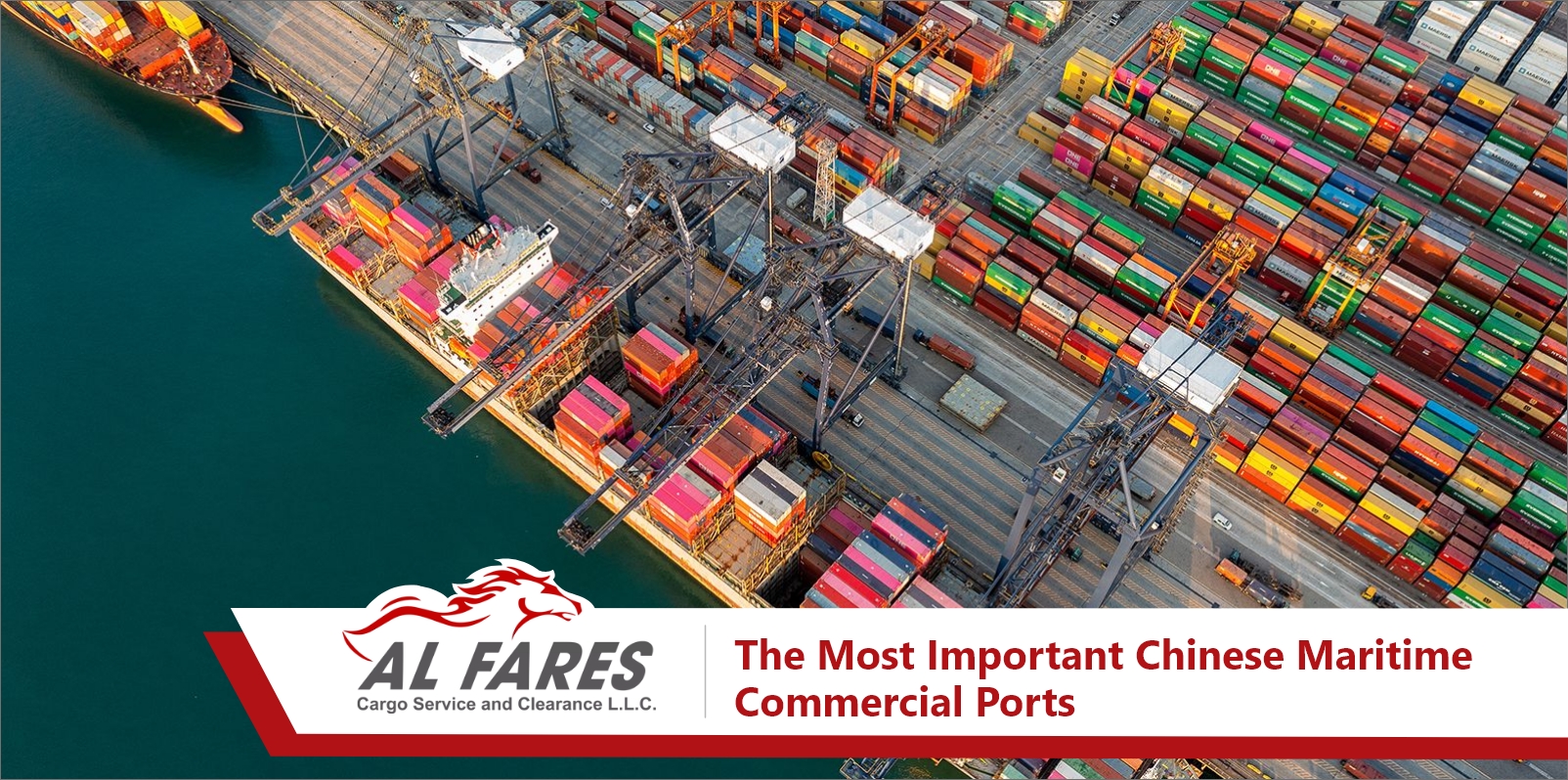China is considered one of the largest trading nations globally, playing a significant role in international maritime trade. Among the factors contributing to this prominent role are a set of modern and advanced maritime commercial ports, serving as the starting points for Chinese cargo and maritime trade. These ports are crucial economic and logistical drivers in the country, playing a decisive role in enhancing international trade and providing efficient transportation channels for goods.
Chinese maritime commercial ports are renowned for their advanced technology and strong infrastructure, allowing them to handle massive cargo volumes and provide efficient logistical services. These ports serve as strategic centers for international trade and maritime commerce, establishing direct links with numerous countries and regions worldwide.
In general, Chinese maritime commercial ports reflect the strength of the Chinese economy and its prominent presence in global trade. These ports are characterized by high technology and efficiency in logistical operations, contributing to the promotion of trade and facilitating the movement of goods across the seas. With the continued development of the Belt and Road Initiative, it is expected that the importance and impact of these ports will persist in the growth and economic development of China and globally.
Key Chinese Maritime Commercial Ports:
Here is a list of the key Chinese maritime commercial ports:
1.Shanghai Port:
- Shanghai Port is one of the largest ports globally and the largest in China in terms of shipping volume.
- Located in the city of Shanghai on the east coast of China, overlooking the East China Sea.
- Known for container trade, maritime transportation, and manufacturing industries.
- Boasts advanced infrastructure and modern facilities supporting international shipping and trade.
- In 2020, the shipping volume at Shanghai Port reached approximately 43.5 million twenty-foot equivalent units (TEU), making it the world's largest port in terms of shipping volume.
2.Ningbo Port:
- Located in the city of Ningbo in Zhejiang province on the coast of the East China Sea.
- One of the largest ports globally in terms of shipping volume and commercial transactions.
- Known for container trade, general cargo, oil and gas, and finished goods.
- Distinguished by its strategic location, providing easy access to the Chinese and global markets.
- In 2020, the shipping volume at Ningbo Port reached about 28.7 million TEU, making it one of the largest ports in the world.
3. Shenzhen Port:
- Located in the city of Shenzhen in Guangdong province in southern China.
- Considered one of the largest maritime ports globally and a major hub for trade and manufacturing.
- Known for container trade, electronics, clothing, and petroleum products.
- Boasts advanced infrastructure and modern technology for loading, unloading, and storage.
- In 2020, the shipping volume at Shenzhen Port reached approximately 27.7 million twenty-foot equivalent units (TEU), making it one of the largest ports in the world in terms of shipping volume.
4. Guangzhou Port:
- Located in the city of Guangzhou in Guangdong province in southern China.
- Guangzhou Port is considered one of the largest maritime ports in China and the world.
- Known for container trade, general goods, metals, chemicals, and coal.
- Serves as a gateway for foreign trade and attracts the presence of many international companies.
- In 2020, the shipping volume at Guangzhou Port reached approximately 21.9 million TEU, making it one of the largest ports in the world.
5. Dalian Port:
- Located in the city of Dalian in Liaoning province in northeastern China.
- Considered one of the largest maritime ports globally and a key hub for trade and transportation in the northeastern region of China.
- Known for grain trade, metals, oil, chemicals, and petroleum products.
- Distinguished by its deep waters, strong infrastructure, and comprehensive logistical services.
- In 2020, the shipping volume at Dalian Port reached approximately 13.7 million twenty-foot equivalent units (TEU), making it one of the largest ports in the world.
6. Tianjin Port:
- Tianjin Port is the second-largest port in China in terms of shipping volume, following Shanghai Port.
- Located in northern China on the Bohai Sea coast, serving as a gateway to the capital, Beijing.
- Known for grain trade, coal, metals, and chemicals.
- Features advanced infrastructure supporting international production and trade.
- In 2020, the shipping volume at Tianjin Port reached approximately 17.3 million TEU.
7. Qingdao Port:
- Located in the city of Qingdao in Shandong province on the coast of the Sea of Japan.
- Considered one of the largest ports globally in terms of shipping volume and transactions.
- Known for general cargo trade, containers, steel products, and petrochemicals.
- Equipped with modern facilities and advanced technology for loading, unloading, and storage.
8. Daxie Port:
- Located in the city of Dalian in Liaoning province in northeastern China.
- Considered one of the largest maritime ports globally and a key hub for international trade and shipping.
- Known for oil and gas trade, grain, metals, and industrial products.
- Provides easy access to neighboring countries such as North Korea, Russia, and Japan.
9. Huangpu Port:
- Located in the city of Guangzhou in Guangdong province in southern China.
- Huangpu Port is part of the Pearl River Delta and is considered a center for maritime trade.
- Known for container trade, general cargo, liquid goods, and oil.
- Provides services for international shipping and trade between China and the world.
10. Xiamen Port:
- Located in the city of Xiamen in Fujian province in southeastern China.
- In 2020, the shipping volume at Xiamen Port reached approximately 11.7 million twenty-foot equivalent units (TEU).
- Known for container trade, general cargo, chemicals, and electronics.
- Serves as a major port for import and export and boasts advanced infrastructure.
11. Nanjing Port:
- Located on the banks of the Yangtze River in eastern China, serving the ancient capital Nanjing.
- Considered an important center for domestic and international trade and inland transportation through the Yangtze River waterway.
- Known for grain trade, general goods, fertilizers, and metals.
12. Fuzhou Port:
- Located in the city of Fuzhou in Fujian province in southeastern China.
- Known for container trade, general cargo, petroleum products, and chemicals.
- Serves as a major center for maritime trade and inland transportation in the region.
13. Shenzhen Port:
- Located in the city of Shenzhen in Guangdong province in southern China.
- Considered the main gateway port for China and a major hub for maritime trade and manufacturing.
- Known for container trade, electronics, clothing, and petroleum products.
Logistic Roles of Chinese Seaports:
Chinese seaports play crucial logistic roles in the economic system and global maritime trade. Here are some key logistic roles these ports undertake:
1.Facilitating International Trade:
Chinese ports serve as a primary gateway for international trade.
They provide services such as shipping, unloading, customs clearance, warehouse management, and distribution, enhancing trade and commercial exchange between China and the rest of the world.
2.Cargo Transportation:
Ports play a vital role in maritime cargo transportation.
Chinese ports boast advanced infrastructure and modern equipment, facilitating efficient and speedy unloading and loading of ships with high capacity for containers, bulk goods, and large vessels.
3.Distribution and Storage of Goods:
Chinese seaports offer modern storage facilities and warehouses with advanced equipment.
These facilities are used for storing and distributing goods through internal logistics networks, roads, and international transport.
4.Development of Economic Zones:
Seaports contribute to the development of special economic zones and free trade areas in China.
These areas provide a suitable business environment, tax exemptions, and customs facilitations to attract domestic and foreign investments, promoting economic growth and foreign trade.
5.Integration of Logistics Transport:
Chinese ports contribute to the integration of logistics transport, including railways, roads, inland navigation, and air transport.
Ports coordinate with other transportation modes to ensure smooth and efficient movement of goods from industrial facilities to ports and onward to final shipping destinations.
6.Promoting Technology and Innovation:
Chinese ports rely on applying technology and innovation in their logistic activities.
Technologies like artificial intelligence are utilized to enhance port operations, making them more efficient and technologically advanced.
7.Facilitating International Trade:
Chinese ports serve as a primary gateway for international trade.
They provide shipping, unloading, customs clearance, warehouse management, and distribution services, enhancing trade and commercial exchange between China and the rest of the world.
8.Cargo Transportation:
Ports play a crucial role in maritime cargo transportation.
Chinese ports feature advanced infrastructure and modern equipment, allowing efficient and speedy unloading and loading of ships. They have high capacity for containers, bulk goods, and large vessels.
9.Distribution and Storage of Goods:
Chinese seaports offer modern storage facilities and warehouses with advanced equipment.
These facilities are used for storing and distributing goods through internal logistics networks, roads, and international transport.
10.Development of Economic Zones:
Seaports contribute to the development of special economic zones and free trade areas in China.
These areas provide a suitable business environment, tax exemptions, and customs facilitations to attract domestic and foreign investments, promoting economic growth and foreign trade.
11.Integration of Logistics Transport:
Chinese ports contribute to the integration of logistics transport, including railways, roads, inland navigation, and air transport.
Ports coordinate with other transportation modes to ensure smooth and efficient movement of goods from industrial facilities to ports and onward to final shipping destinations.


 Track Your Shipment
Track Your Shipment
 Online Enquiry
Online Enquiry
 Sign In
Sign In
 English
English

 Alfares Cargo
Alfares Cargo
 Logistic Informations
Logistic Informations
 2023-12-21
2023-12-21












